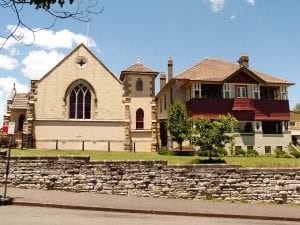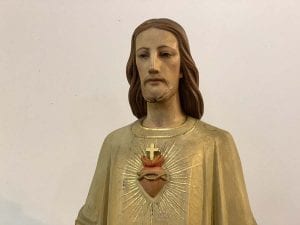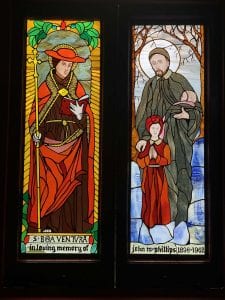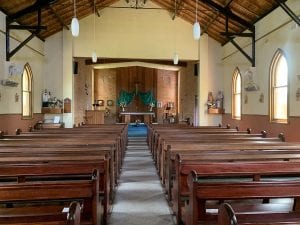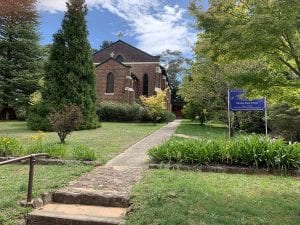02 4782 2804 | bluemountains@parracatholic.org
02 4782 2804
bluemountains@parracatholic.org

OUR PARISH
St Mary of the Cross MacKillop Parish is located in the Upper Blue Mountains west of Sydney, NSW, Australia.
Travelling westward along the Great Western Highway through the Blue Mountains, our Parish extends from Wentworth Falls, through to Leura and on to Katoomba. Our Parish Office is located at 158 Katoomba Street, Katoomba.
Our Parish is home to three churches:
St Canice's Katoomba, St Bonaventure's Leura and St Francis Xavier's Wentworth Falls.
OUR HISTORY
The Parish of St Mary of the Cross MacKillop Upper Blue Mountains was formed with the amalgamation of the parishes of Katoomba and Leura in 1992.
The Katoomba Parish was founded in 1890 while the Leura Parish was founded in 1948.
St Canice's Church in Katoomba forms part of the rich history of the Blue Mountains going back as far as the 1800s, when pioneering priests discovered that escaped convicts from Emu Plains had settled among the Aboriginal communities in the Megalong Valley.
The first Mountains' parish was established in 1841 as the Bathurst Mission, served from Hartley.
St Canice's was preceded by a small weatherboard church, which was begun in 1887. The tiny church - 14 metres x 7 metres -cost £160 ($320).
In 1890, Rev James McGough, an Irish priest in his early 40s, who had been ordained at All Hallows, departed for the "foreign mission" of Australia.
He spent two years in Maitland, NSW, before going to Katoomba, where he became pastor of Katoomba, the centre of the Parish of the Blue Mountains.
He named his new church St Canice's after a Gaelic saint born in County Derry about 516.
Fr McGough was faced with many challenges in the early months of his tenure at Katoomba, such as the indifference of local Catholics to going to church. Even when the bishop visited, Fr McGough could think of barely 10 parishioners who would want to attend Mass.
His parish was 30 miles (48km) from one end to the other, Penrith on one side of the Mountains and Lithgow on the other. His biggest obstacle was communication.
Fr McGough had to travel on horseback spending many days and nights in the saddle, in sometimes inhospitable weather on tracks that were often impossible to negotiate even on horseback, to alert his parishioners to the fact that his small weatherboard church was waiting and welcoming.
After 10 difficult years, Fr McGough resigned in October 1900 to be replaced by a larger-than-life character, Rev St Clair Joseph Bridge, a 40-something priest who took the parish by the scruff of the neck and reputedly "pulled it alongside the hooves of his thundering horse".
Fr Bridge, the son of a wealthy wool merchant, was described as "a bit unstable", a "little odd" and "eccentric on a large scale".
He had been born in Dundee Scotland, and claimed kinship to Cardinal Moran.
The eccentricity of the new incumbent soon became evident. At services men sat on the left side of the church (with boys at the front) and women on the right (girls at the front).
The doors were locked when Mass commenced and were not re-opened until the Mass was over.
Fr Bridge was popular though, and generous; he always remembered the collectors and wardens every Christmas and was meticulous in giving his altar boys some pocket money every Saturday night.
During his tenure he oversaw a frenzy of building, culminating in the laying and blessing of the foundation stone of St Canice's by Cardinal Moran in 1902.
The Blue Mountains Parish thrived in the early 1900s with churches in Mt Victoria, Springwood, Blackheath, Wentworth Falls and Megalong; there were ceremonies every week to do with new schools, churches or convents.
The parish thrived because the Mountains thrived.


Parish Priests & Administrators
| Katoomba Fr James McGough Fr St Clair Joseph Bridge Fr John McCulloch |
1890-1900 1900 |
| Upper Blue Mountains Fr Peter Dowd Fr James Dooley Fr Robert Anderson Fr John Smith Fr Edward Tyler Fr Carlos Walker IVE Fr Sean Bradley IVE Fr Omar Mazzega IVE Fr. John McSweeney Fr. Abraham Kunnatholy Varu CMI |
1992-1994 1993-1996 1994-2004 2004-2011 2011-2018 2018-2020 2018-2019 2019-2020 2020-present 2020-present |
OUR SAINTS

St Mary of the Cross MacKillop
St Mary of the Cross MacKillop - Australia's first declared Saint - is the Patroness of our Upper Blue Mountains Parish.
Mary MacKillop was an ordinary woman who lived an extraordinary life.
She was born in Fitzroy, Melbourne on 15 January 1842 to Scottish immigrants Alexander and Flora MacKillop and died in North Sydney on 8 August 1909.
After living what she described as "a most unhappy" early life, largely due to financial hardship, Mary moved to Penola, South Australia at age 18 to work as a governess for relatives.
There she met Fr Julian Tenison Woods and they set up a school for underprivileged children before going on to establish the Sisters of St Joseph of the Sacred Heart - the first religious institute established by an Australian. The Order grew and the Sisters travelled the countryside setting up schools, orphanages and other good works for those in need.
In 1871 Mary was excommunicated following a dispute with the Bishop of Adelaide, but the following year, the Bishop lifted the excommunication order and exonerated Mary of any wrongdoing. She travelled to Rome by sea in 1873/74 to have the rule of her Order approved by the Pope himself.
Today, there are about 800 Sisters of St Joseph, still working with the poor and marginalised in Australia, New Zealand, Timor Leste, Scotland, Ireland and Peru.
The road to Sainthood
Even at the time of her death, those who knew her, or knew of her extraordinary work, spoke openly of her holiness - her heroic goodness. The official Cause for the Canonisation of Mary MacKillop was begun in 1925. In January 1995, Pope John Paul II beatified Mary during a Mass at Randwick Racecourse, Sydney. This followed official recognition of a woman being miraculously cured of cancer after praying for Mary's intercession. The recognition in December 2009 of a second miracle, also a woman being cured of cancer, ensured Mary's path to Canonisation.
Our Upper Blue Mountains Parish joined the worldwide celebrations, as our Patron was Canonised in Rome on 17 October 2010.
St Mary of the Cross MacKillop was also proclaimed the Patron of the Catholic Diocese of Parramatta during the Diocese's Silver Jubilee Mass of Thanksgiving in St Patrick's Cathedral Parramatta on Thursday 19 May 2011.

St Francis Xavier
The Patron Saint of our parish church at Wentworth Falls and of missionaries and one of the founders of the Jesuit order, St Francis Xavier sought religious converts throughout Asia during the 1500s.
"In this life, we find our greatest comfort living in the midst of danger, that is, if we confront them solely for the love of God."
- Saint Francis Xavier
On 7 April 1506, Francis Xavier was born in Xavier Castle, located near Sangüesa, in the kingdom of Navarre (part of present-day Spain). He was a member of a noble family, and his childhood was one of privilege - however, it was disrupted by his father's death, as well as by outside efforts to take control of Navarre.
Forming the Jesuit Order
In 1525, Xavier went to study at the University of Paris. There, he encountered Ignatius of Loyola, who had experienced a religious conversion while recovering from a war wound. Loyola did his utmost to convince Xavier to join him on the same path of devotion.
Though at first hesitant, Xavier was eventually inspired by his friend's example. On 15 August 1534, in the Montmartre section of Paris, Xavier, Loyola and five others pledged themselves to the Society of Jesus (the Jesuits). In addition to vows of celibacy and poverty, they also promised to visit the Holy Land.
While waiting in Venice, Italy, to depart for the Holy Land, Xavier worked in a hospital, aiding those in need. He also became a priest, on 24 June, 1537. When fighting between Venice and the Ottoman Empire made a trip to Jerusalem impossible, Xavier instead went to Rome, where he and others in the society offered their services to the pope.

St Canice
St Canice is the Patron Saint of our church in Katoomba and the patron of sailors in a storm.
St Canice (Anglicised as Kenny) was a monk of deep learning and compassion. He was renowned for his friendship with St Columkille (Columba) of Iona in Scotland.
Legend has it that when Columkille and his small crew of monks became caught in a violent storm while rowing there, Canice instinctively heard their frightened cries. Rushing to the chapel, he prayed for their safety and all was well.
St Canice was born in 515 or 516, at Glengiven, near Dungiven in Ireland. His full name was Cainnech moccu Dalánn.
Canice spent his early years watching his chieftain's flocks. In 543 St Canice became a pupil at Finnian's monastic school at Clonard. During the 6th Century, some of the most significant names in the history of Irish Christianity studied at the Clonard monastery. St Canice was one of 12 students who studied under St Finnian who became known as the Twelve Apostles of Ireland. It was at Clonard that St Canice became a friend and companion of St Colmcille (Columba).
In 544 he studied under St Mobhi at the school of Glasnevin, with Kieran of Clonmacnoise and St Comgall of Bangor. When plague scattered that community, he went to Saint Cadoc's monastery of Llancarfan in Glamorganshire in Wales, where he was ordained a priest in 545.
He left for Rome to obtain the blessing of the reigning pontiff. In 550 he had returned to Glengiven, where he converted his foster-brother, Geal-Breagach, who afterwards assisted him in founding Drumachose, in nearby Limavady.
In 565 St Canice joined Columba in Scotland, where he is known as St Kenneth. Adamnan tells of the arrival of St Canice, on Iona. St Columba had a prophecy of a "certain holy and excellent man, who will arrive here among us before evening". According to Adamnan, God provided St Canice with a safe and calm crossing, even though the sea was perilous and stormy that day. St Columba received him that evening with all honour and hospitality.
St Canice built a church in the place now known as Saint Andrews. He built monastic cells on the island of Ibdon and Eninis, an oratory called Lagan-Kenny on the shores of Loch Laggan (the remains of which are marked on the OS map), and a monastery in Fife on the banks of the Eden. St Canice's name is still recalled in the ruins of an ancient church, Kil-Chainnech on Tiree Island, in a burial ground, Kil-Chainnech, in Iona and Inch Kenneth off Mull.
St Canice spent a good deal of his time in County Meath and Ossory in what is now County Laois. In Ossory he had a good repute with the king, Colmann son of Feradach. Colman gave him grants of land including Aghaboe ("the field of the Ox") which became his principle monastery.
In his old age Canice retired to an island in what was once Loch Cree, and wrote a commentary on all four Gospels. This became known as Glass Kinnich (Glas-Chainnigh) or Chain of Cainnec This was long preserved in his church and became a continuous commentary in the Middle Age.

St Bonaventure
St Bonaventure is the Patron Saint of our church at Leura.
St Bonaventure, known as "the seraphic doctor", was born at Bagnorea in Tuscany, in 1221. He received the name of Bonaventure in consequence of an exclamation of St Francis of Assisi, when, in response to the pleading of the child's mother, the saint prayed for John's recovery from a dangerous illness, and, foreseeing the future greatness of the little John, cried out "O Buona ventura" - O good fortune!
At the age of 22, St Bonaventure entered the Franciscan Order. Having made his vows, he was sent to Paris to complete his studies under the celebrated doctor Alexander of Hales, an Englishman and a Franciscan. After the latter's death, he continued his course under his successor, John of Rochelle. In Paris he became the intimate friend of the great St Thomas Aquinas. He received the degree of Doctor, together with St Thomas Aquinas, ceding to his friend against the latter's inclination, the honour of having it first conferred upon him. Like St Thomas Aquinas, he enjoyed the friendship of the holy King, St Louis.
At the age of 35 he was chosen General of his Order and restored a perfect calm where peace had been disturbed by internal dissensions. He did much for his Order and composed The Life of St Francis. He also assisted at the translation of the relics of St Anthony of Padua. He was nominated Archbishop of York by Pope Clement IV, but he begged not to be forced to accept that dignity. Gregory X obliged him to take upon himself a greater one, that of Cardinal and Bishop of Albano, one of the six suffragan Sees of Rome. Before his death he abdicated his office of General of the Franciscan Order. He died while he was assisting at the Second Council of Lyons, on 15 July 1274.


